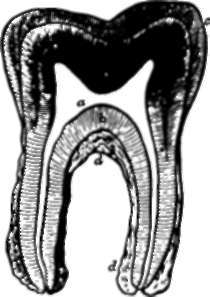53. The Teeth
Description
This section is from the book "Animal Physiology: The Structure And Functions Of The Human Body", by John Cleland. Also available from Amazon: Animal Physiology, the Structure and Functions of the Human Body.
53. The Teeth
Under this term, in its widest signification, may be included all hard structures for the trituration of the food; and these are of many different kinds, and found in different positions. In certain molluscs, e.g., the genus Bulla, and in Crustacea, e.g., the lobster and crab, teeth of shell are developed in the walls of the stomach; and both in Crustacea and insects, modified limbs, called jaws, are used for the seizure of food: in the cuttle fishes, the same function is performed by a horny beak in two parts like that of a bird; and in other molluscs by the rasping action of minute plates set on a long muscular tongue. In the vertebrata, the same variety of structures for breaking down the food exists. Birds and turtles have beaks which are horny developments of the integument covering the jaws, and graminiverous birds have not only muscular gizzards, but by swallowing stones, furnish themselves with temporary stomachic teeth of a most efficient description.
Even among teeth, properly so called, namely, structures impregnated with mineral matter, there is great variety. In fishes and reptiles, they may be jointed to bones by means of ligament, or welded to them immovably, and may be attached to numerous bones abutting on the oral cavity; indeed, true teeth occur (Synodontis) lying in the integument unconnected with any bone. In crocodiles, the teeth are in large sockets. In mammals, they are confined to the inferior, superior, and inter-maxillary bones, and are fastened in closely fitting sockets, so that, when full grown, they cannot drop out, even when the bones have been macerated.
A tooth, such as may be obtained from the human subject, consists of a crown projecting above the gum, and a root imbedded in a socket of the jaw, and the place where these meet is called the neck. The root may consist of one fang or several; and at the extremity of each fang is a little opening leading into a cavity in the interior of the tooth, which is filled with a soft and sensitive substance called the pulp, while the blood-vessels and nerve of the pulp pass through the little opening. The main mass of the hard substance of the tooth is cornposed of a structure called dentine, and this is covered in the crown with a cap of enamel, and in the root with crusla petrosa.

Fig. 43. Incisor Tooth, vertical section, a, pulp cavity; b, b, dentine showing the general curves of the tubes and three contour lines crossing them; c, enamel, with coloured bands crossing its prisms; d, crusta petrosa.

Fig. 44. Molar Tooth, vertical section; letters same as in fig. 43.
Continue to:
